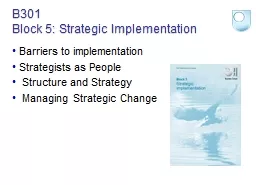

Barriers to implementation Strategists as People Structure and Strategy Managing Strategic Change Block 5 explores Implementation Analysis Choice Johnson and Scholes 2006 Implementation ID: 651767
Download Presentation The PPT/PDF document "B301 B lock 5: Strategic Implementation" is the property of its rightful owner. Permission is granted to download and print the materials on this web site for personal, non-commercial use only, and to display it on your personal computer provided you do not modify the materials and that you retain all copyright notices contained in the materials. By downloading content from our website, you accept the terms of this agreement.
Slide1
B301Block 5: Strategic Implementation
Barriers to implementationStrategists as People Structure and Strategy Managing Strategic ChangeSlide2
Block 5 explores ‘Implementation’
Analysis
Choice
Johnson and Scholes’ (2006)
ImplementationSlide3
Block 5 overviewUnit 1: Barriers (Alexander 1985 & Hrebiniak 2006); Tools: CPA, Gantt charts, Control loop, double loop learning. Hickson et al 2003 planned/prioritised implementation. Success factors
Unit 2: People: Regner (2003) summarised; middle manager functions; TMT/MM interaction (Raes et al., 2011) – decision/implementation quality; consultants.interface of senior/middle management reading 14 (Raes et al.)U3: Structure and strategy; low/high context structural discourse; Mintzberg on structure; Raisch on real-life structuresbalanced structures reading 15 (
Raisch
)
U4: Change: causes and nature of change (planned, incremental, punctuated equilibrium); scale/scope of change (
Balogun
and Hope-Hailey, 2008), implementation model (
Hrebniak
, 2006)Obstacles to implementation reading 16 (Hrebiniak)Slide4
Alexander’s five key obstaclesKey tasks are not defined in enough detailProblems requiring intervention by top management were not communicated to them fast enough
Changes in roles and responsibilities were not clearly definedThe key formulators of the strategic decision did not play an active enough role in implementationMajor problems surfaced during implementation, which had not been identified beforehandSlide5
Hrebiniak’s consulting experience revealed obstacles managers have to overcome
Managers are trained to plan not executeLet the ‘Grunts’ handle executionPlanning and execution are interdependentImplementation takes longer than formulation
Execution involves more people than formulation
Unit 1 (
introduction). Unit
4
(Reading
16)
5Slide6
Confirm agreement (2)
Receive Stock
Carry out minor works
(20)
Install racking
(10)
Facilitating Implementation –
Critical Path Analysis
Set up ordering systems (20)
Recruit and train staff (18)
Confirm lines (5)
Decide Staffing (2)
Send off first orders (5)
Decide layout
etc
(10)
Install signage (7)Slide7
Facilitating Implementation – Gantt ChartSlide8
Control Loop
Possible action:Adjust task/resourcesPossible action:Do nothingSlide9
Control loops and ‘out of the box’Difference between single and double loopsArgyris and Schon (1978) double loops show strategic learning and critical thing: question the firm’s goals
Morgan’s (1986) proposals for developing DL learningSlide10
Hickson et al (2003)Factors in successful strategic implementation‘Planned’ and ‘prioritised’ optionsPlanned: based on experiencePrioritised: based on ‘readiness’
Case study of glass manufucturingSlide11
Strategists as PeopleJarzabkowski et al (20007)Regner (2003) on managersRaes at al (2011) on strategic interactionWright et al’s (2008) six questions about strategy consultants
Strategy as a ‘social activity’Senior ManagersMiddle Managers (beyond the ‘classical’ view)Interaction of senior and middle managers (Raes et al)Strategy consultants: questioning some assumptions, and Wright et al’s 6 questions (2008)Slide12
Senior and middle manager interactions (Raes et al, 2011)Slide13
Structure discourse (more on discourse coming up in Block 6)A different way of thinking about strategy‘Ontological’: the nature of what is taken as ‘reality’Child (2000) ‘low’ and ‘high’ contexts‘Low’: assumes a ‘best practice’. Friedman’s (2006) view that globalisation is ‘flattening‘ the world. Mimetic isomorphism in organisations: same for strategies?.
‘High’: (Segal Horn and Faulkner, 2012) recognition and focus on specific contexts, embracing ‘messiness’Geppert at al (2002 )consider hybrid contextsSlide14
Mintzberg’s six ‘ideal’ structural types
Simple Structure
Machine
Bureaucracy
Professional Bureaucracy
Divisionalised
Form
Adhocracy
Missionary
Key part
Strategic apex
Technostructure
Operating core
Middle line
Support staff
Ideology
Coordinating mechanism
Direct supervision
Standardisation of work processes
Standardisation of skills
Standardisation of outputs
Mutual adjustment
Standardisation of norms
Dominant pull to:
centralise
standardise
professionalise
balkanise
collaborate
evangelise
(Mintzberg
1979)Slide15
Temporal Separation
Organisations change back and forth between different corporate structuresDecentralisation is used to ignite innovation and change: centralisation to increase coordination and efficiencyExploitation and exploration are emphasized sequentially rather than simultaneouslySlide16
Structural Separation
Organisations are divided into two (or more) separate units with different structures at the same timeFlexible ‘innovative units’ explore new areas for growth, while more formal ‘operational units ensure efficient organisations in the existing businesses
Exploitation and exploration are addressed by different employees and organisational unitsSlide17
Parallel Structures
Organisations create supplemental network structures to compliment the formal primary structureEmployees switch between the two types of strucutres
depending on their respective tasks
Exploitation and exploration are addressed by the same employees, but in different structural environmentsSlide18
Managing Strategic ChangeWhat is the difference between the planned and the incremental view of change?
What is ‘punctuated equilibrium’?According to Balogun and Hope Hailey (2008) what are the four types of strategic change (depending on the nature and scope of change)?18Slide19
Balogun and Hope Hailey
19
Evolution
Adaption
Revolution
Reconstruction
Transformation Realignment
Big Bang Incremental
Scope of Change
Nature of Change
Balogun
and Hope Hailey (2008)Slide20
Hrebiniak 2006
Hrebiniak’s model for implementing strategic change